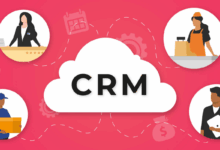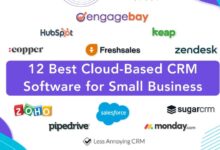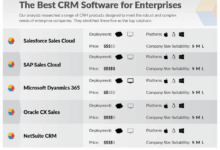CRM for Sales and Marketing Automation
CRM for Sales and Marketing Automation represents a powerful synergy, streamlining processes and boosting efficiency. By integrating sales and marketing functions within a centralized system, businesses gain valuable insights into customer behavior, optimize lead generation, and nurture relationships more effectively. This integration fosters collaboration, improves data accuracy, and ultimately drives revenue growth.
This comprehensive guide explores the core functionalities of such systems, highlighting key differences between sales-focused and integrated solutions. We’ll delve into sales process optimization, the power of marketing automation within the CRM, and the critical importance of data management and integration. Finally, we’ll examine the return on investment (ROI) and future trends shaping this dynamic field.
Defining CRM for Sales and Marketing Automation
A Customer Relationship Management (CRM) system, when designed for both sales and marketing automation, acts as a central hub for managing all customer interactions. It streamlines processes, improves team collaboration, and ultimately drives revenue growth by providing a unified view of the customer journey. This integrated approach contrasts sharply with standalone systems, offering significant advantages in efficiency and data-driven decision-making.
Core Functionalities of an Integrated CRM System
A CRM system designed for both sales and marketing encompasses a broad range of functionalities. On the sales side, this includes contact management, lead tracking, opportunity management, sales forecasting, and reporting on sales performance. Marketing functionalities typically involve campaign management, email marketing, lead nurturing, social media integration, marketing automation workflows, and analytics to measure marketing ROI. The integration of these functions allows for seamless handoff between sales and marketing, providing a holistic view of the customer lifecycle.
Key Differences Between Sales-Focused and Integrated CRMs
Sales-focused CRMs primarily concentrate on managing the sales pipeline and tracking individual deals. They offer features for managing contacts, leads, and opportunities, but lack the sophisticated marketing automation capabilities found in integrated systems. Integrated CRMs, conversely, go beyond sales management by incorporating tools for automating marketing campaigns, nurturing leads, and analyzing marketing performance. This allows for a more strategic approach to customer acquisition and retention, enabling businesses to personalize their interactions at scale.
Examples of Improved Efficiency Through Integrated CRM Features
Consider a scenario where a marketing campaign identifies high-potential leads. In an integrated CRM, these leads are automatically routed to the appropriate sales representatives, complete with detailed information about their engagement with the marketing materials. This eliminates manual data entry and ensures that sales teams follow up promptly. Conversely, sales teams can provide feedback to marketing on lead quality, allowing for continuous campaign optimization. Another example involves tracking customer journeys across multiple channels. An integrated CRM can provide a complete picture of customer interactions, allowing both sales and marketing to tailor their messaging and offers for better engagement and conversion rates.
Comparison of Leading CRM Platforms
| Feature | Salesforce Sales Cloud | HubSpot CRM | Microsoft Dynamics 365 |
|---|---|---|---|
| Sales Automation | Strong: Lead management, opportunity tracking, forecasting, sales analytics | Good: Contact and deal management, pipeline visualization | Strong: Lead and opportunity management, sales process automation |
| Marketing Automation | Strong: Email marketing, marketing automation workflows, campaign management, analytics | Excellent: Comprehensive marketing automation suite, lead nurturing, A/B testing | Good: Email marketing, lead scoring, basic marketing automation |
| Integration Capabilities | Excellent: Wide range of integrations with other business applications | Good: Integrations with popular marketing and sales tools | Good: Integrates well with other Microsoft products |
| Pricing | Varied, based on features and user count, typically higher cost | Offers free and paid plans, scalable pricing | Varied, based on features and user count, competitive pricing |
Sales Process Optimization with CRM
A Customer Relationship Management (CRM) system is more than just a contact list; it’s a powerful tool for optimizing the entire sales process, from lead generation to customer retention. By centralizing customer information, automating tasks, and providing insightful analytics, a well-implemented CRM significantly improves sales efficiency and profitability. This section will explore how CRMs streamline sales workflows and enhance performance.
Effective CRM utilization transforms the often chaotic sales process into a structured, manageable system. This allows sales teams to focus on building relationships and closing deals rather than administrative tasks. The integration of sales automation features significantly reduces manual effort, enabling a more scalable and efficient sales operation. Furthermore, the data-driven insights provided by CRM analytics empower businesses to make informed decisions, predict future performance, and proactively address potential challenges.
Lead Management and Opportunity Tracking
Effective lead management is crucial for sales success. A CRM system provides a centralized repository for all lead information, including contact details, interaction history, and lead source. This allows sales representatives to easily access and manage leads, ensuring no potential customer is overlooked. Furthermore, the system facilitates lead scoring and prioritization, allowing sales teams to focus their efforts on the most promising leads. Opportunity tracking within the CRM enables sales representatives to monitor the progress of each sales opportunity, identify potential roadblocks, and take timely corrective actions. This includes features for managing deal stages, forecasting closing dates, and recording communication history. By providing a clear overview of the sales pipeline, the CRM empowers sales managers to make informed decisions about resource allocation and sales strategies.
Streamlining Sales Workflows
CRMs significantly streamline sales workflows by automating repetitive tasks such as email marketing, appointment scheduling, and follow-up reminders. This frees up sales representatives’ time to focus on high-value activities, such as building relationships and closing deals. For instance, automated email sequences can nurture leads throughout the sales funnel, while automated reminders ensure timely follow-ups, increasing the likelihood of conversion. Workflow automation features within the CRM can also help to ensure consistent sales processes across the entire team, leading to improved efficiency and predictability. Imagine a scenario where a new lead enters the system. Automated rules trigger an email welcome sequence, schedule a call with a sales representative, and automatically update the lead’s status as it progresses through the sales funnel.
Sales Analytics and Performance Improvement
CRM systems provide robust analytics capabilities that offer valuable insights into sales performance. Sales managers can track key metrics such as conversion rates, average deal size, and sales cycle length. This data can be used to identify trends, pinpoint areas for improvement, and measure the effectiveness of sales strategies. For example, analyzing conversion rates at different stages of the sales funnel can highlight bottlenecks and inform strategies for improving efficiency. Furthermore, CRM analytics can help to identify top-performing sales representatives and understand their success factors, allowing for knowledge sharing and best-practice implementation across the team. Predictive analytics features, increasingly common in modern CRMs, can forecast future sales performance based on historical data, allowing businesses to proactively adjust their strategies and optimize resource allocation. For instance, by analyzing historical sales data and market trends, a CRM might predict a potential dip in sales during a particular quarter, allowing the sales team to develop a proactive strategy to mitigate this risk.
Workflow Diagram: CRM Support for the Sales Process
Imagine a flowchart. The process begins with *Lead Generation*, where potential customers enter the system via various channels (website forms, marketing campaigns, referrals). These leads are then *Qualified* based on pre-defined criteria (lead scoring). Qualified leads progress to the *Sales Engagement* stage, involving personalized communication and relationship building, tracked meticulously within the CRM. The next step is *Opportunity Management*, where deals are tracked through various stages (prospecting, qualification, proposal, negotiation, closing). Once a deal is closed, the customer moves to the *Customer Onboarding* phase, integrating them into the post-sales support system. Finally, the CRM facilitates *Customer Retention* through ongoing communication, feedback collection, and proactive support, ensuring long-term customer relationships. This entire process, from lead generation to customer retention, is supported and optimized by the CRM’s features, offering real-time visibility and control at each stage.
Marketing Automation within the CRM
Integrating marketing automation directly into your CRM system streamlines your sales and marketing efforts, creating a more efficient and effective process. This synergy allows for a more holistic view of the customer journey, from initial contact to conversion and beyond, enabling data-driven decisions and personalized interactions. By leveraging the combined power of CRM and marketing automation, businesses can significantly improve their lead generation, nurturing, and overall marketing ROI.
A robust CRM system equipped with marketing automation capabilities offers a centralized platform for managing all customer interactions and automating various marketing tasks. This integration eliminates the need for disparate systems and manual data entry, reducing errors and saving valuable time. This allows marketing and sales teams to focus on strategic initiatives rather than tedious administrative tasks.
Key Marketing Automation Features within a CRM
Several key features significantly enhance marketing efforts when integrated within a CRM. These tools work together to provide a comprehensive solution for managing and optimizing marketing campaigns.
- Email Marketing: Automated email sequences for lead nurturing, triggered emails based on specific actions (e.g., website visits, form submissions), personalized email campaigns based on customer segmentation, and A/B testing capabilities for optimizing email performance.
- Social Media Management: Scheduling and publishing social media posts across multiple platforms, monitoring social media mentions and engagement, and tracking social media campaign performance. This allows for a coordinated and consistent brand presence across various social media channels.
- Campaign Tracking and Analytics: Real-time tracking of campaign performance metrics, including open rates, click-through rates, conversion rates, and ROI. This provides valuable insights into what’s working and what needs improvement, enabling data-driven optimization.
Lead Nurturing Approaches Using CRM-Integrated Marketing Automation
Different approaches to lead nurturing cater to various customer segments and buying cycles. Choosing the right strategy is crucial for maximizing engagement and conversion rates.
Two common approaches are drip campaigns and personalized workflows. Drip campaigns utilize pre-defined email sequences sent automatically based on a schedule or specific triggers. Personalized workflows, on the other hand, adapt to individual customer behaviors and interactions, offering more tailored content and experiences. For example, a customer who downloads a whitepaper might receive a follow-up email with related case studies, while another customer who attends a webinar might receive an invitation to a product demo.
Metrics for Measuring Marketing Automation Campaign Effectiveness
Tracking key metrics provides crucial insights into the success of marketing automation campaigns. This data informs adjustments to strategies, ensuring optimal performance and return on investment.
- Email Metrics: Open rates, click-through rates, conversion rates, unsubscribe rates, and bounce rates.
- Website Metrics: Website traffic, time spent on site, pages visited, and conversion rates.
- Social Media Metrics: Engagement rate, reach, impressions, and follower growth.
- Lead Generation Metrics: Number of leads generated, lead conversion rate, and cost per lead.
- Sales Metrics: Revenue generated from marketing automation campaigns, customer lifetime value, and return on investment (ROI).
Improving Customer Segmentation and Personalization with Marketing Automation
Marketing automation within a CRM significantly enhances the ability to segment customers and personalize interactions. This leads to more effective campaigns and improved customer relationships.
By analyzing customer data such as demographics, purchase history, website behavior, and engagement with marketing materials, businesses can create highly targeted segments. This allows for the delivery of highly relevant content and offers, increasing engagement and conversion rates. For instance, a company selling software could segment customers based on industry and company size, tailoring their marketing messages to address specific needs and challenges within each segment. This targeted approach significantly improves the effectiveness of marketing campaigns compared to a generic, one-size-fits-all approach.
Integration and Data Management
Effective CRM implementation hinges on seamless data integration and robust management. A unified system allows sales and marketing teams to access and utilize the same information, fostering collaboration and improving overall efficiency. This eliminates data silos and promotes a holistic view of the customer journey.
Data integration between sales and marketing departments, facilitated by a CRM, is crucial for building a comprehensive understanding of customer interactions. By centralizing data from various sources – marketing campaigns, sales interactions, customer service tickets – businesses gain a 360-degree view of each customer. This integrated perspective allows for more targeted marketing campaigns, personalized sales pitches, and improved customer service.
Centralized Database Benefits
A centralized database offers significant advantages. The consolidation of sales and marketing data into a single repository drastically improves data accuracy. Duplicate entries are minimized, inconsistencies are resolved, and the risk of outdated information is reduced. Furthermore, improved accessibility allows both sales and marketing teams to access the same, up-to-date information, eliminating discrepancies and promoting a shared understanding of the customer base. This shared understanding improves decision-making and enhances the overall effectiveness of marketing and sales strategies. For example, a marketing team can leverage sales data to tailor campaigns to specific customer segments identified as high-potential leads, while the sales team can leverage marketing data to understand customer preferences and personalize their interactions.
Data Cleansing and Integrity
Maintaining data integrity requires a proactive approach to data cleansing. This involves identifying and correcting inaccurate, incomplete, or irrelevant data. Processes such as deduplication, standardization of data formats, and validation rules help ensure data accuracy. Regular data audits and automated cleansing tools can further enhance data integrity. Implementing strict data entry protocols and providing training to users on proper data entry procedures are also critical. Failing to address data quality issues can lead to flawed analyses, inaccurate forecasting, and ultimately, poor business decisions. For instance, inaccurate contact information can result in missed sales opportunities and ineffective marketing campaigns.
Challenges and Solutions to Data Integration
Effective data integration presents some challenges. Successfully navigating these obstacles requires careful planning and execution.
- Data Silos: Overcoming pre-existing data silos within different departments requires a concerted effort to break down departmental barriers and foster collaboration. Solutions include implementing robust data governance policies and investing in training programs to ensure all employees understand the importance of data integration and how to use the CRM effectively.
- Data Migration Issues: Migrating data from legacy systems to a new CRM can be complex and time-consuming. Careful planning, including data mapping and validation, is crucial to minimize errors and ensure a smooth transition. Phased migration strategies can help reduce disruption to business operations.
- Data Security and Privacy Concerns: Protecting sensitive customer data is paramount. Implementing robust security measures, such as access controls and encryption, is crucial to comply with data privacy regulations and build customer trust. Regular security audits and employee training on data security best practices are also essential.
- Integration Complexity: Integrating the CRM with other systems, such as marketing automation platforms or e-commerce platforms, can be technically challenging. Careful selection of compatible systems and engaging experienced IT professionals are essential to ensure successful integration.
- Lack of Standardization: Inconsistent data formats across different sources can hinder integration efforts. Implementing data standardization procedures and establishing clear data governance policies can address this challenge. For instance, establishing consistent naming conventions for customer fields ensures data uniformity across the CRM and other systems.
Return on Investment (ROI) and Measuring Success
Implementing a CRM for sales and marketing automation represents a significant investment. Understanding and tracking its return on investment (ROI) is crucial for justifying the expenditure and demonstrating its value to the business. This section details methods for calculating ROI and outlines key performance indicators (KPIs) that provide insights into the system’s effectiveness.
Calculating the ROI of a CRM system involves comparing the benefits gained against the costs incurred. This requires a comprehensive understanding of both the initial investment and the ongoing operational expenses. The benefits are often harder to quantify, requiring careful consideration of improvements across various aspects of the business.
Calculating CRM ROI
The basic formula for calculating ROI is:
(Return – Investment) / Investment * 100%
. The “Investment” includes the initial software licensing fees, implementation costs (consulting, training, data migration), and ongoing maintenance and support fees. The “Return” is more complex and needs to be carefully calculated by considering increased sales revenue, improved sales efficiency, reduced marketing costs, and enhanced customer satisfaction. For example, if a company invests $10,000 in a CRM and experiences a $20,000 increase in sales revenue directly attributable to the CRM’s capabilities, the ROI would be ((20000 – 10000) / 10000) * 100% = 100%. This is a simplified example; a more realistic calculation would involve factoring in other costs and benefits.
Key Performance Indicators (KPIs) for CRM Success
Several KPIs can effectively measure the success of a CRM implementation. These KPIs should align with the overall business objectives. Tracking these metrics provides valuable insights into areas of strength and weakness, guiding adjustments to optimize the CRM’s use.
| KPI | Description | Measurement | Example |
|---|---|---|---|
| Sales Conversion Rate | Percentage of leads converted into customers. | (Number of Customers / Number of Leads) * 100% | Increased from 5% to 10% after CRM implementation. |
| Customer Acquisition Cost (CAC) | Cost of acquiring a new customer. | Total Marketing and Sales Costs / Number of New Customers | Reduced from $500 to $300 per customer. |
| Customer Lifetime Value (CLTV) | Predicted revenue generated by a customer throughout their relationship with the company. | Average Purchase Value * Average Purchase Frequency * Average Customer Lifespan | Increased from $1000 to $1500 per customer. |
| Marketing ROI | Return on investment for marketing campaigns. | (Revenue Generated – Marketing Costs) / Marketing Costs * 100% | Improved from 15% to 25% after implementing marketing automation features within the CRM. |
Reporting and Analytics for Measuring Success
CRM systems typically include robust reporting and analytics dashboards. These tools allow for the visualization of key metrics, identifying trends, and making data-driven decisions. The ability to generate custom reports and analyze data across different dimensions is crucial for understanding the impact of the CRM on various aspects of the business. For instance, a sales manager can track individual sales representative performance, identify top-performing products, and analyze sales trends by region. Marketing teams can assess campaign effectiveness, track lead generation sources, and measure customer engagement.
Visual Representation of Key Metrics
Visualizing data through charts and graphs enhances understanding and facilitates decision-making. For example:
| Metric | Chart Type | Example |
| Sales Revenue Over Time | Line Chart | A line chart showing an upward trend in sales revenue following CRM implementation. |
| Lead Source Performance | Pie Chart | A pie chart showing the percentage of leads generated from different sources (e.g., website, email marketing, social media). |
| Sales Conversion Rate by Sales Rep | Bar Chart | A bar chart comparing the conversion rates of individual sales representatives. |
| Customer Satisfaction Scores | Scatter Plot | A scatter plot showing the correlation between customer satisfaction scores and other metrics, such as response time or resolution time. |
Future Trends in CRM for Sales and Marketing Automation
The landscape of Customer Relationship Management (CRM) is constantly evolving, driven by rapid technological advancements and shifting customer expectations. Understanding these emerging trends is crucial for businesses seeking to optimize their sales and marketing efforts and maintain a competitive edge. The integration of cutting-edge technologies is transforming how businesses interact with their customers, leading to more efficient processes and personalized experiences.
The convergence of several technological advancements is reshaping the future of CRM. AI and machine learning are at the forefront, enabling systems to analyze vast amounts of data, predict customer behavior, and automate complex tasks. This leads to more efficient workflows and improved decision-making across sales and marketing teams.
Artificial Intelligence and Machine Learning in CRM
AI and machine learning are revolutionizing CRM functionality. AI-powered chatbots provide instant customer support, while machine learning algorithms analyze sales data to predict future trends and identify high-potential leads. For example, a CRM system using machine learning could analyze past sales data to predict the likelihood of a specific lead converting into a customer, allowing sales teams to prioritize their efforts effectively. This predictive capability allows for proactive engagement and resource allocation, maximizing efficiency and return on investment. Furthermore, AI can personalize marketing campaigns by segmenting audiences based on individual preferences and behaviors, leading to higher conversion rates.
Predictive Analytics and Personalized Customer Experiences
Predictive analytics, powered by AI and machine learning, allows CRM systems to anticipate customer needs and behaviors. This capability goes beyond simple lead scoring; it allows for the creation of highly personalized customer journeys. For instance, a CRM system might predict that a customer is likely to churn based on their recent activity and automatically trigger a retention campaign, such as a personalized discount offer or a proactive check-in from a customer service representative. This proactive approach strengthens customer relationships and reduces churn rates. The ability to deliver hyper-personalized experiences fosters stronger customer loyalty and increased sales.
Adapting to Evolving Customer Expectations and Technological Advancements
Modern customers expect seamless, personalized experiences across all touchpoints. CRM systems are adapting to meet these expectations by integrating with various channels, including social media, email, and messaging apps. This omnichannel approach provides a unified view of the customer, allowing businesses to deliver consistent and relevant interactions regardless of the communication method. Furthermore, the increasing adoption of mobile devices necessitates CRM systems that are accessible and user-friendly on all platforms. This ensures that sales and marketing teams can access and utilize customer data anytime, anywhere. Companies like Salesforce have continually adapted their platform to reflect these changing needs, offering mobile-first interfaces and integrations with a vast array of communication tools.
Impact of Emerging Trends on Sales and Marketing Strategies
The integration of AI, machine learning, and predictive analytics is fundamentally changing sales and marketing strategies. Sales teams can leverage predictive models to prioritize leads, personalize their outreach, and improve closing rates. Marketing teams can create highly targeted campaigns, personalize customer journeys, and measure the effectiveness of their efforts with greater precision. Ultimately, these advancements lead to increased efficiency, improved customer satisfaction, and a higher return on investment. For example, a company using AI-powered CRM to identify at-risk customers might be able to reduce churn by 15%, resulting in significant cost savings and revenue retention. This data-driven approach allows for continuous optimization and improvement of sales and marketing strategies.
Final Conclusion
Implementing a CRM for sales and marketing automation is a strategic decision that can significantly impact a business’s bottom line. By leveraging the insights and tools provided, companies can enhance customer relationships, streamline workflows, and achieve measurable improvements in sales and marketing performance. The future of CRM lies in leveraging emerging technologies like AI and machine learning to further personalize customer experiences and optimize business processes, ensuring sustained growth and competitive advantage.





